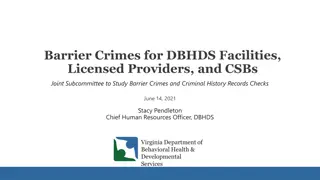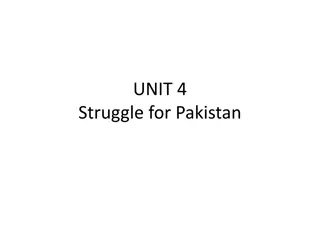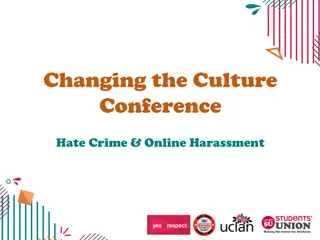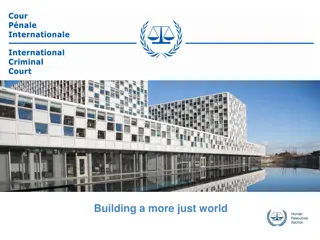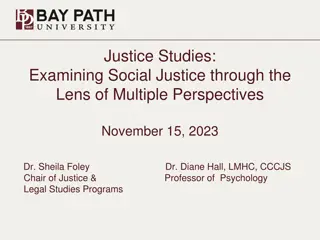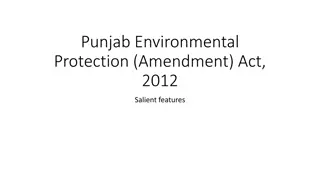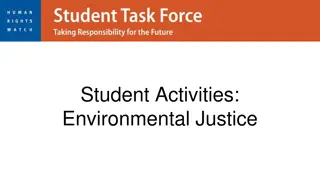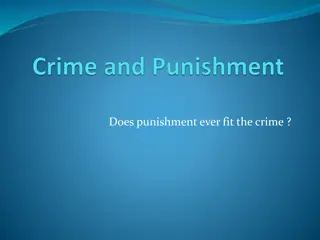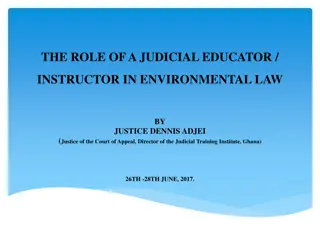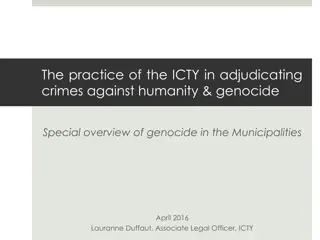Imprisonment for Environmental Crimes: Impact and Controversy in the Justice System
Exploring the debate around imprisoning individuals for environmental crimes, this content delves into the definitions of green crimes, the environmental cost of mass incarceration, and statistics on the imprisonment rates of polluting decision-makers. It questions the necessity and effectiveness of imprisonment as a deterrent for environmental violations.
Download Presentation

Please find below an Image/Link to download the presentation.
The content on the website is provided AS IS for your information and personal use only. It may not be sold, licensed, or shared on other websites without obtaining consent from the author.If you encounter any issues during the download, it is possible that the publisher has removed the file from their server.
You are allowed to download the files provided on this website for personal or commercial use, subject to the condition that they are used lawfully. All files are the property of their respective owners.
The content on the website is provided AS IS for your information and personal use only. It may not be sold, licensed, or shared on other websites without obtaining consent from the author.
E N D
Presentation Transcript
Imprisonment Imprisonment for environmental environmental crime for and as and as crime Cameron Russell Australian Prison Reform Journal www.aprj.com.au
Acknowledgement of Country I acknowledge and pay my respects to past, present and emerging Elders and Custodians of the land on which we meet, the Larrakia people. Their stolen lands have never been ceded.
Overview Should we imprison individuals more often when they commit serious green crimes? Is imprisonment itself a green crime? PowerPoint: aprj.com.au (refer Vol.2, Iss.4, Art.3)
Green crimes definition (1) Law-based definition: Illegal activities and/or omissions that harm, destroy, degrade, threaten or place at risk the environment, ecology and/or species (amalgam of definitions by AFP, Europol, Situ & Emmons, Higgins, Walters)
Green crimes definition (2) Non-law-based (or harm-based) definition: Grave offenses against the environment, ecology and/or species including any activities and/or omissions that cause them harm, destruction, degradation, threat or risk (akin to Earth lawyer, Polly Higgins definition of ecocide which linked severely diminished peaceful enjoyment with international crimes under the Rome Statute being against peace)
Jewkes and Moran: the expansion of correctional systems has been widely criticized by criminologists and others for its financial and human costs but the environmental cost of mass incarceration has yet to attract widespread critique.
What proportion of polluting decision-makers are jailed? Belgium: 10-15% EU: <2.5% Ireland: 0% Netherlands: 2.6% UK: 0.58% US: 22-56% of criminal judicial cases, but these are only 11% of cases (so the imprisonment rate is only 2.4-6%)
What proportion of Australian polluters are jailed? In the NSWLEC in the past 5 yrs: 1.3% imprisoned 1.3% received a CCO 92.4% received a fine 36.7% received a publication order 8.9% received a remedial order
Environmental lobby has been demanding jail terms because: Uni of Adelaide study: Co heads embroiled in environmental disasters generally suffer little reputational damage (Moodie 2016; Liu et al. 2016) These dinosaurs may pollute for profit if just fined/slapped on wrist Greater likelihood of prison would seriously concentrate the mind of polluters - Jojo Mehta, Co-founder of Stop Ecocide (DW 2021: 0min 53sec).
Should green criminologists advocate imprisoning polluters (or anyone else)? Even if decision-maker seriously polluted for profit, and Even if prison were effective in punishing/deterring them It is submitted that green criminologists should not advocate imprisonment due to the following 3 green injustices of mass incarceration:
1. Environmental injustice Environmental discrimination stems from the environmental racism movement (1970s-80s): disadvantaged people observed to live in inferior environments with less nature and more waste Prisoners are from disadvantaged backgrounds & live in inferior environments
Environmental injustice - Reported examples Temperature extremes (e.g. Roebourne C.C. & Alice Springs C.C.) Mouse and cockroach infestations (e.g. Hakea Prison & Wellington C.C.); Overcrowding(e.g. Darwin C.C. & John Moroney C.C.) Not evacuated when floods and fires nearby (e.g. Lithgow C.C. and Geoffrey Pearce C.C.) Built on swamps (e.g. John Moroney C.C.) or contaminated former landfill/industrial sites (e.g. the site in Camellia, Western Sydney proposed for a prison for 1000 inmates) (Tanton et al. 2021:11; Farcic 2013; Gregory and Lowther 2021; Edwards 2022; Bradshaw 2018)
Environmental injustice - Specific example: Silverwater 1163-inmate prison built on landfill (Bradshaw Rubbish Tip) Soil known to contain moderate to high levels of contamination 2.5m to 13m of waste fill below thin 1m clay surface layer as a cap (which is leaking gas so a health & fire risk for prisoners & Sydneysiders)
Environmental injustice - Silverwater (cont.) Prison extended for 440 prisoners. Environmental assessment: Significant contamination Toxins identified: Benzene, toluene, BTEX, PAHs, OCPs, PCBs, many heavy metals, asbestos, PFAS & much more Water from this toxic site also draining 700m into Parramatta River
2. Ecological injustice Prisons (and prison museums) are vast areas of concrete and bitumen with the occasional lawn, but largely devoid of creeks, lakes, trees and natural grasslands. In addition, tonnes of building materials and water are expended, along with energy, during the construction process
Ecological Injustice example: Clarence CC Australia s largest prison (197 ha, 1700 prisoners) 62 buildings + admin buildings + carpark for 700 + concrete and bitumen in between
Local Environment Plan: Clarence C.C. (cont.) Fails to meet multiple requirements of the Development Control Plan, e.g.: Development which is responsive to site constraints and the surrounding environment Development which is of high quality and is sensitive to the rural character of the locality in which it is being developed Built on Rural Landscape (RU2) land Not 1 of the 8 RU2 objectives fulfilled
3. Species injustice In constructing prisons, State and Territory governments have demonstrably failed to protect and improve native biodiversity and habitats of significant species as required by planning, development & environmental requirements Governments do this by introducing enabling legislation, paying offsets, etc
Species injustice example: Ravenhall C.C. 40.5 ha site (+ 6.6 ha surrounds) High value grasslands destroyed Significant flora and fauna species on the site
Species injustice example: Ravenhall C.C. (cont.) Biosite of State significance included 16.35 ha of native vegetation, 0.02 ha of high conservation significance and 7.26 ha of very high conservation significance Minister for Planning determined an Environmental Effects Statement (EES) not required DOJ paid offsets for the destruction
Offsets Governments routinely pay offsets when constructing prisons. However, under State, Territory and Federal legislation, offsets are generally an exceptional option only after attempting to avoid or mitigate any impacts. Even then, offsets are not to make an unacceptable impact acceptable. You just can t offset critical habitat of this nature (Greens Environment spokesperson, Rosalie Woodruff 2021)
Conclusion (cont.) Prisons (including the oxymoron green prisons ) perpetuate ineffective retributive justice and green injustices; are a huge burden on the tax system; and are themselves green crimes in the sense of causing grievous harm to the environment John Braithwaite: Restorative justice techniques first, offering carrots but reserving the stick of imprisonment as a last resort (Braithwaite 2019).
Conclusion (cont.) Scott sees no need for a new Northern Prison in Tasmania if the Government invests the same amount in crime causes, rehabilitation, prison-based reintegration, and community services for employment, housing, education, training and other support Cunneen et al. advocate early release; abolition of short sentences; justice reinvestment; therapeutic jurisprudence such as the use of drug courts; specialist courts for mentally ill, homeless or Aboriginal people; & attention to colonialism, post colonialism & race as drivers of incarceration
Selected references Available to view at your leisure at: aprj.com.au (Vol.2, Iss.4, Art.3)
Thank you Contact details: PowerPoint: Cameron Russell e: info@aprj.com.au aprj.com.au Vol.2, Iss.4, Art.3
Selected references Aertsen I (26 April 2019) Restorative justice responses to environmental harm and ecocide , International Seminar, Katholieke Universiteit Leuven, Belgium. AFP (Australian Federal Police) (n.d.) Environmental crime , accessed 09 April 2022. Artefact (2018) Metropolitan Remand and Reception Centre: Heritage Impact Assessment: Report to the Department of Justice on behalf of GHD , accessed 29 April 2022. BBC Consulting Planners (2017) Environmental Impact Statement: New Grafton Correctional Centre , Broadway, NSW. Billiet C and Rousseau S (2014) How real is the threat of imprisonment for environmental crime? , European Journal of Law and Economics, 37(2):183 198, doi: 10.1007/s10657-011-9267-2 Bradshaw EA (2018) Tombstone towns and toxic prisons: Prison ecology and the necessity of an anti- prison environmental movement Critical Criminology, 2018. Braithwaite J (2002) Restorative justice and responsive regulation , in Tonry M and Morris N (eds) Studies in crime and public policy, Oxford University Press, Oxford. Cunneen C, Baldry E, Brown D, Brown M, Schwartz M and Steel A (2016) Penal culture and hyperincarceration: The revival of the prison, Advances in Criminology series, Routledge, London.
Selected references (cont.) CVC (Clarence Valley Council) (2011) Rural Zones: Development Control Plan , Clarence Valley Council, NSW. (2020) Local Strategic Planning Statement , accessed 13 April 2022. (2022) Lot 1 of Plan No 1190399 & Lot 26 of Plan No 751376 , Cadastre for Clarence Correctional Centre, Avenue Road, Lavadia, NSW. DW News (Deutsche Welle News) (2021a) Ecocide explained: How activists want to hold those destroying the environment accountable , accessed 24 March 2022. EC (European Commission) (2016) Is prison a real threat for environmental offenders? , Science for environment policy, accessed 25 May 2022. Edwards J (18 January 2022) Incarceration in a changing climate , Eureka Street, 32(1), accessed 24 April 2022. Europol (n.d.) Environmental crime , accessed 03 April 2022. Farcic E (17 January 2013) Hakea prison divided, vermin infested , The West Australian, accessed 24 April 2022. GHD (2018) Metropolitan Remand and Reception Centre Expansion: Review of environmental factors , NSW Department of Justice.
Selected references (cont.) Gregory X and Lowther N (22 June 2021) Mouse plague 'invades' Wellington prison, forcing hundreds of prisoners and staff to evacuate , ABC News, accessed 24 April 2022. Higgins P, Short D and South N (2013) Protecting the planet: a proposal for a law on ecocide , Crime, Law and Social Change, 59(3):251-266. Jewkes Y and Moran D (2015) The paradox of the green prison: Sustaining the environment or sustaining the penal complex , Theoretical Criminology, 19(4):451-469. Knaus C (29 December 2017) Prisons at breaking point but Australia is addicted to incarceration , The Guardian, accessed 28 May 2022. Liu C, Aharony J, Richardson G and Yawson A (2016) Corporate litigation and changes in CEO reputation: Guidance from U.S. Federal Court lawsuits , Journal of Contemporary Accounting & Economics 12(1):15-34, https://doi.org/10.1016/j.jcae.2016.02.003 Lynch MJ, Stretesky PB and Long MA (2019) Environmental crime prosecutions in Ireland 2004-2014 , International Journal of Comparative and Applied Criminal Justice, 43(4):277-293, doi: 10.1080/01924036.2019.1615520 Melton City Council (gazettal date: 31 January 2013) Melton Planning Scheme: Amendment C136: Explanatory Report , accessed 31 May 2022. Moodie A (13 March 2016) Getting off scot-free: how CEOs survive environmental controversies unscathed , The Guardian (Australia), accessed 11 April 2022. NSW Caselaw (2022) Recent decisions for Multiple Courts, Criminal , accessed 01-31 May 2022.
Selected references (cont.) NSW Correctional Services (2020) Silverwater Correctional Complex upgrade , NSW Government, accessed 29 April 2022. NSWLEC (Land and Environment Court of New South Wales) (2020a) About us , NSW Government, accessed 13 April 2022. (2020b) Enforcement , NSW Government, accessed 13 April 2022. (2020c) Types of cases , NSW Government, accessed 13 April 2022. Scott C (22 June 2020) New Northern Regional Prison Bad policy in action , Tasmanian Times, accessed 29 April 2022. Situ Y and Emmons D (2000) Environmental crime: The criminal justice system s role in protecting the environment , Sage Publications, https://dx.doi.org/10.4135/9781452232256 Symes C (1997) Environmental law: Polluting activities , Alternative Law Journal, 22(4):196-197. Tanton R, Dare L, Miranti R, Vidyattama Y, Yule A and McCabe M (2021) Dropping off the Edge 2021: Persistent and multilayered disadvantage in Australia , Jesuit Social Services, Melbourne. Victorian Government (2014) Ravenhall Prison: Correctional facility development plan , accessed 25 May 2022.
Selected references (cont.) Wahlquist C (19 March 2020) Australia's overcrowded prisons could struggle to control coronavirus, expert says; Governments urged to show a similar level of care to protecting prisons as they do to protecting aged care homes , The Guardian, accessed 28 May 2022. Walters R (2019) Ecocrime , in McLaughlin E and Muncie J (eds) Sage Dictionary of Criminology, Sage Publications (4th ed), London. Westcott V and McCutcheon C (2013) Ravenhall Grasslands Nature Conservation Reserve: Flora survey: Final report , Biosis (for Department of Justice). Woodruff R (2021a) Ashley Youth Detention Centre Future use of site , Tasmanian Greens MPs, accessed 13 April 2022. Legislation Clarence Valley Local Environment Plan 2011 (NSW) Contaminated Land Management Act 1997 (NSW) [the CLM Act] Environment Protection and Biodiversity Conservation Act 1999 (Cth) [the EPBC Act] Environmental Planning and Assessment Act 1979 (NSW) [the EP&A Act] Environmental Planning and Assessment Regulation 2000 (NSW) [the EP&A Regulation] Land and Environment Court Act 1979 (NSW) [the LEC Act]
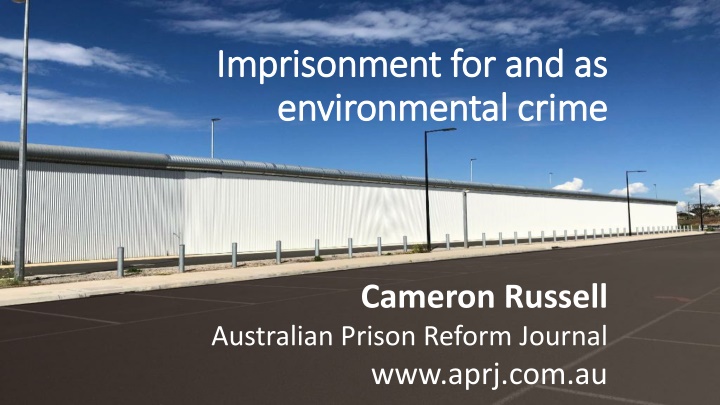

![Prevention and Combating of Hate Crimes and Hate Speech Bill [B.9B.2018]](/thumb/60513/prevention-and-combating-of-hate-crimes-and-hate-speech-bill-b-9b-2018.jpg)





